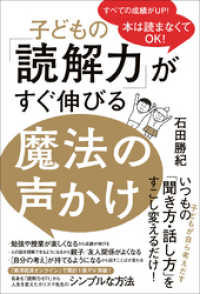- ホーム
- > 洋書
- > 英文書
- > History / World
Full Description
It is widely known that such Western institutions as the museum, the university, and the penitentiary shaped Japan's emergence as a modern nation-state. Less commonly recognized is the role played by the distinctly hybrid institution—at once museum, laboratory, and prison—of the zoological garden. In this eye-opening study of Japan's first modern zoo, Tokyo's Ueno Imperial Zoological Gardens, opened in 1882, Ian Jared Miller offers a refreshingly unconventional narrative of Japan's rapid modernization and changing relationship with the natural world. As the first zoological garden in the world not built under the sway of a Western imperial regime, the Ueno Zoo served not only as a staple attraction in the nation's capital—an institutional marker of national accomplishment—but also as a site for the propagation of a new "natural" order that was scientifically verifiable and evolutionarily foreordained. As the Japanese empire grew, Ueno became one of the primary sites of imperialist spectacle, a microcosm of the empire that could be traveled in the course of a single day. The meaning of the zoo would change over the course of Imperial Japan's unraveling and subsequent Allied occupation. Today it remains one of Japan's most frequently visited places. But instead of empire in its classic political sense, it now bespeaks the ambivalent dominion of the human species over the natural environment, harkening back to its imperial roots even as it asks us to question our exploitation of the planet's resources.
Contents
Figures
Foreword by Harriet Ritvo
Acknowledgements
Note on Transliteration
INTRODUCTION
Japan's Ecological Modernity
I. Animals in the Anthropocene
II. Ecological Modernity in Japan
III. The Natural World as Exhibition
PART ONE
The Nature of Civilization
CHAPTER ONE:
Japan's Animal Kingdom: The Origins of Ecological Modernity and the Birth of the Zoo
I. Bringing Politics to Life
II. Sorting Animals Out in Meiji Japan
III. Animals in the Exhibitionary Complex
IV. The Ueno Zoo
V. Ishikawa Chiyomatsu and the Evolution of Exhibition
VI. Bigot's Japan
CHAPTER TWO:
The Dreamlife of Imperialism: Commerce, Conquest, and the Naturalization of Ecological Modernity
I. The Dreamlife of Empire
II. The Nature of Empire
III. Nature Behind Glass
IV. Backstage at the Zoo
V. The Illusion of Liberty
VI. Imperial Trophies
VII. Imperial Nature
PART TWO
The Culture of Total War
CHAPTER THREE:
Military Animals: The Zoological Gardens and the Culture of Total War
I. Military Animals
II. Mobilizing the Animal World
III. The Eye of the Tiger
IV. Animal Soldiers
V. Horse Power
CHAPTER FOUR:
The Great Zoo Massacre
I. Tokyo, 1943
II. A Strange Sort of Ceremony
III. Mass-Mediated Sacrifice
IV. The Taxonomy of a Massacre
V. The Killing Floor
VI. And Then There Were Two
PART THREE
After Empire
CHAPTER FIVE:
The Children's Zoo: Elephant Ambassadors and Other Creatures of the Allied Occupation
I. Bambi Goes to Tokyo
II. Empire After Empire
III. Neo-Colonial Potlatch
IV. "Animal Kindergarten"
V. Occupied Japan's Elephant Mania
VI. Elephant Ambassadors
CHAPTER SIX:
Pandas in the Anthropocene: Japan's "Panda Boom" and the Limits of Ecological Modernity
I. The "Panda Boom"
II. The Science of Charisma
III. Panda Diplomacy
IV. "Living Stuffed Animals"
V. The Biotechnology of Cute
EPILOGUE:
The Sorrows of Ecological Modernity
Notes
Bibliography
Indext
-

- 電子書籍
- この恋、茶番につき!? 分冊版(49)
-

- 電子書籍
- 短歌研究 2025年 05・06月 合…
-

- 電子書籍
- ジムニー・スーパースージー No.143
-

- 電子書籍
- ニューモデルマガジンX 2024年3月号
-

- 電子書籍
- 子どもの「読解力」がすぐ伸びる魔法の声…



